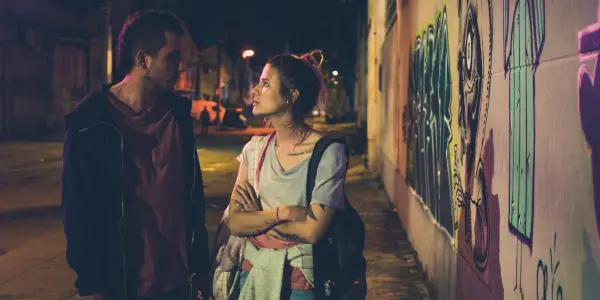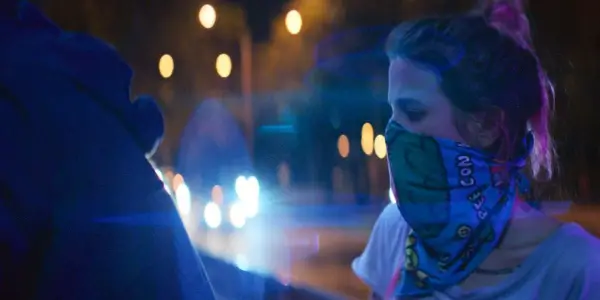DAYS OF THE WHALE: An Irresistibly Muted Portrait Of Adolescence

Andrew Stover is a film critic/writer from the Chicagoland. His…
While money and fear buy power, art has the capacity to defy it, and acquire power of its own by showing the unembellished truth. Art is power. Art is truth. And art is rebellion. At least for teenagers Cristina (Laura Tobón Ochoa) and Simón (David Escallón), who reside in Medellin, Colombia.
Catalina Arroyave’s directorial debut, Days of the Whale (Los Días De La Ballena), is a raw depiction of youth that unfolds on the busy, gang-ridden streets of Medellin. The film follows two teenagers, Cristina and Simón, two graffiti artists who are evolving lovers, trudging through their urban setting with secrecy and agility.
Cristina and Simón aren’t the only two recalcitrant artists roaming the city in search of unadorned walls. As it turns out, Cristina and Simón are part of an artist collective helmed by Lucas (Carlos Andrés Fonnegra). But Medellin is, of course, occupied by drug kingpins, and they are wringing money from Lucas for “protection”. Simón lives with his grandmother in a strait apartment. While he had affiliations with the gang in the past, Simón broke ties with the gang out of fear. Cristina originates from an upper-middle-class family. She lives with her father and his younger wife. Her mother, who’s only ever seen via Skype calls, is a journalist who moved to Spain to evade the local gang violence.
As the gang members get a whiff of an artist collective pamphlet which contains artwork rebelling against the gang’s sovereignty, the gang defaces the wall near their sanctuary with a threatening slogan: “Snitches get stitches”. Feeling empowered and defiant, Cristina and Simón paint over the threat with white paint. Big mistake.
Despite there being a good chance that there’s now a target on their backs, Cristina and Simón still venture the city, wandering the streets and underpasses, spray-painting dreadfully white walls with colorful pictures. As Cristina and Simón’s platonic relationship turns romantic, they get caught under the hypnotic haze of love, nestling closely together and laughing at their own misadventures.
An Impressively Understated Portrait Of Rebellious Youth
The opening sequence sees Cristina and Simón finding a homeless dog on the street, and taking the poor little fella with them. Unable to keep the dog at his home, Simón leaves the dog with Lucas, a decision that will predictably backfire. The first act doesn’t yield too much drama and principally focuses on Cristina and Simón’s spray-painting excursions. During these late-night excursions, fluid camerawork and a diverse soundtrack of Colombian rock and hip hop inject the scenes with teen-esque vitality.

After the gang spray paints a minacious slogan on the wall near the artist collective center, there’s palpable tension between Cristina and Simón, as the intractable Simón wants to challenge the threat and paint over it while Cristina is more reluctant. In the end, they paint over it, and their relationship is impeded by Simón’s recklessness.
Cristina has a few fleeting yet quietly affecting moments with her father and mother. While the supporting cast is not wholly utilized, they are still operating at full capacity. Cristina’s father is a concerned parent who wants the best for Cristina, but Cristina doesn’t appreciate his concern, largely because he got himself a new and younger woman, and Cristina’s continually annoyed by her. Cristina’s mother is only ever seen via video chat, and what is seen of their interactions, they have a healthily spirited relationship. So good a relationship, in fact, Cristina is supposed to go to Spain to be with her mom, but her relationship with Simón extends her stay at Medellin.
Simón comes from a working-class background, and he lives with his loving grandmother who doesn’t try to heavily scrutinize Simón’s whereabouts. While the story doesn’t expand beyond Cristina and Simón’s restricted perspectives — both of which are distinguished by slight social class polarity — a dismal part of Simón’s past is revealed. In the hands of an eager director, this divulgence would elicit bouts of melodrama, prompting Cristina to storm off and question everything Simón has ever told her. Arroyave is more diligent, letting Cristina’s intricate expressions foreground a moment of silent reflection over an inflated reaction.

Cristina and Simón’s graffiti antics, short-sighted rebellion, and budding romance build to a typical coming-of-age formula. Even so, Days of the Whale doesn’t hinge on intensified drama or tragedy. Overflowing with sparkling ardor, the film has a purposeful rhythm to it. Being a teenager traditionally comes with a fervent urge to express yourself in a bold fashion. Graffiti art just happens to be Simón and Cristina’s undying form of expression that cannot be painted over, even when savage gangs continue to foist their laws and emphasize their threats.
The Art Of The Whale
Catalina Arroyave’s debut is aesthetically audacious. Exercising visual restraint and subdued conflict, Arroyave favors a veristic style. She wholly fulfills this quality by interlacing a grounded screenplay, trembling handheld camerawork, and a general storyline that is not grotesquely permeated with gang violence (which has been exploited in many films that take place in Medellin). Admittedly, Simón’s future may be in peril. It’s easy to come to that conclusion because the pivotal predicament centers around an act of rebellion carried out against the gang patrolling the neighborhood. Fealties are broken, or further distorted, as Simón’s past is conveniently exhumed.
The teenage rebellion presented in Days of the Whale is filtered through art, an art form that can communicate messages appealing to the eyes and mind. The scenes in which Simón and Cristina tag the walls with a mixture of colors are underlined by extreme close-ups, vivifying the beauty and potency of the art they’re creating.

The romance between Cristina and Simón is beautifully envisioned through body language and micro-expressions. Laura Tobón Ochoa and David Escallón are two expressional performers, both naturally assuming their unruly roles as young and furtively vulnerable lovers running amok. Also running amok is the primary metaphor that gives the film its title. Although underdeveloped, the metaphor is enlivened by the film’s final shot, which reveals that Cristina and Simón found inspiration in a whale of all mammals — which makes thematic sense considering that a whale customarily symbolizes strength and perseverance, two attributes that the young lovers have shown by painting over an elementary (though certainly real) threat of violence.
Days of the Whale Is A Notable & Favorable Debut
Catalina Arroyave’s Days of the Whale is a deliberately sedate and outwardly discreet coming-of-age tale that is vividly drawn up through faint expressions and layered performances. While familial threads remain undercooked, Days of the Whale is not meant to probe every facet that affects Cristina and Simón’s lives.
As a patient and attentive viewer, you follow Cristina and Simón in the urban streets of Medellin over the course of a few days, where they wield art as their preferred weapon against gang supremacy that blemishes their neighborhood. While the tension boils over at one point, Days of the Whale is a rather delicate, quiet, and immersive exploration of adolescence.
Despite taking place in a city with a ubiquitous gang subculture, Days of the Whale is unconventionally warm and luminous. Truly, a piece of art to behold, especially considering the future projects Catalina Arroyave Restrepo will end up designing.
Have you seen Days of the Whale? If not, are you interested in seeing it now? Let us know in the comments!
Days of the Whale was released in select U.S. theaters on July 24, 2020.
Watch Days of the Whale
Does content like this matter to you?
Become a Member and support film journalism. Unlock access to all of Film Inquiry`s great articles. Join a community of like-minded readers who are passionate about cinema - get access to our private members Network, give back to independent filmmakers, and more.
Andrew Stover is a film critic/writer from the Chicagoland. His film & TV reviews can be found on Film Inquiry & Film Threat.













